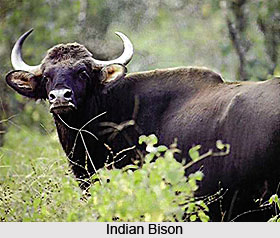 Indian Bison or Gaur is one of the most impressive of the world`s wild oxen with adult bulls weighing up to 1000 kg and standing 190 cm at the shoulder. The young are a golden fawn colour, whilst cows and young bulls are dark coffee-brown colour with distinctive white stockings on their legs. The bulls when mature are covered with short black glossy hair and have a high bony ridge extending from their shoulders and ending abruptly over the loins. They have a yellow or grizzled area on the forehead and white-stocking feet. Both sexes of the species bear smooth cylindrical upsweeping horns, which are orange yellow in colour among young animals and becomes olive in older bulls. The horn-spread may be as much as 85 cm between tips with individual horns up to 80 cm in length. There are two distinct and separate dewlaps, a small one under the chin and the other one on the brisket. There is no white caudal patch in the Indian Bison as in the Banteng or wild ox of Malaysia.
Indian Bison or Gaur is one of the most impressive of the world`s wild oxen with adult bulls weighing up to 1000 kg and standing 190 cm at the shoulder. The young are a golden fawn colour, whilst cows and young bulls are dark coffee-brown colour with distinctive white stockings on their legs. The bulls when mature are covered with short black glossy hair and have a high bony ridge extending from their shoulders and ending abruptly over the loins. They have a yellow or grizzled area on the forehead and white-stocking feet. Both sexes of the species bear smooth cylindrical upsweeping horns, which are orange yellow in colour among young animals and becomes olive in older bulls. The horn-spread may be as much as 85 cm between tips with individual horns up to 80 cm in length. There are two distinct and separate dewlaps, a small one under the chin and the other one on the brisket. There is no white caudal patch in the Indian Bison as in the Banteng or wild ox of Malaysia.
In India bisons have now reduced in numbers, being limited to scattered populations in the Western Ghats Mountain Range, in Madhya Pradesh and Orissa and in the Himalayan foothill regions of Assam and Bhutan. They are shy and retiring beasts despite their massive size and their numbers have been reduced by successive felling of forest, grass burning and other human disturbances. They graze during the wet season but can subsist upon browse during the dry season and eat a variety of herbs, fallen fruits and bamboo leaves. They feed mostly during the hours of darkness, lying up to chew the cud by day in the shelter of the forest. Generally they keep in small herds of two or three animals ranging up to 40, usually with an old cow being the dominant animal. Mature bulls commonly live a solitary existence or travel in pairs. The breeding season of the Indian bisons in Karnataka is from November to March while in Kanha National Park the breeding lasts from December to January. A single calf is born after a nine-month gestation period and cows appear to mate for the first time when two-and-a-half years old and they produce one calf each year.
Like all oxen, the Indian bison has an acute sense of smell but rather poorly developed eyesight. They are always very alert for predators, but both tigers and leopards take a toll of the newly-born calves, with adult animals occasionally being attacked. They are also very susceptible to the diseases which had affected domestic cattle, and in the famous Bandipur National Park in Karnataka the magnificent herds of bison were practically wiped out by an epidemic of rinderpest in the late 1960s, from which they are yet to recover.



















